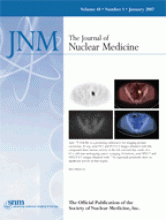Abstract
PET with [11C]-(R)-PK11195 is currently the modality of choice for the in vivo imaging of microglial activation in the human brain. In this work we devised a supervised clustering procedure and a new quantification methodology capable of producing binding potential (BP) estimates quantitatively comparable with those derived from plasma input with robust quantitative implementation at the pixel level. Methods: The new methodology uses predefined kinetic classes to extract a gray matter reference tissue without specific tracer binding and devoid of spurious signals (in particular, blood pool and muscle). Kinetic classes were derived from an historical database of 12 healthy control subjects and from 3 patients with Huntington's disease. BP estimates were obtained using rank-shaping exponential spectral analysis (RS-ESA) (both plasma and reference input) and the simplified reference tissue model (SRTM). Comparison between plasma- derived BPs and those produced with the new reference methodology was performed using 6 additional healthy control subjects. Reliability of the new methodology was performed on 4 test–retest studies of patients with Alzheimer's disease. Results: The new algorithm selected reference voxels in gray matter tissue avoiding regions with specific binding located, in particular, in the venous and arterial circulation. Using the new reference, BP values obtained using a plasma input and a reference input were in excellent agreement and highly correlated (r = 0.811, P < 10−5) when calculated with RS-ESA and less so (r = 0.507, P < 0.005) when SRTM was used. In the production of parametric maps, SRTM was used with the new reference extraction, resulting in test–retest variability (10.6%; mean ICC = 0.878) that was superior to that obtained using the previous unsupervised clustering approach (mean ICC = 0.596). Conclusion: Reference region modeling combined with supervised reference tissue extraction produces a robust and reproducible quantitative assessment of [11C]-(R)-PK11195 studies in the human brain.
Footnotes
-
COPYRIGHT © 2006 by the Society of Nuclear Medicine, Inc.







